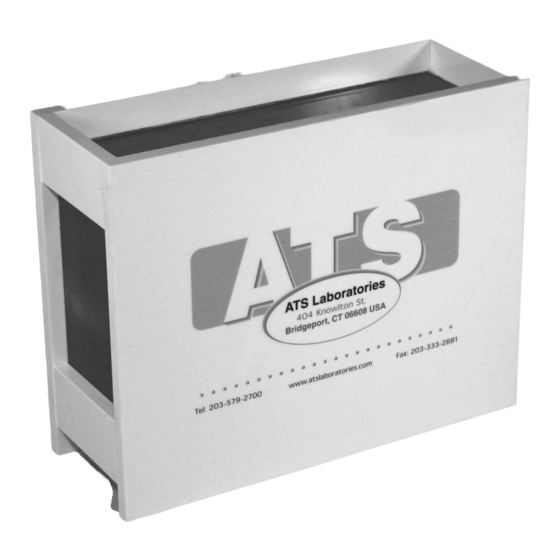ATS 570 Manuale di istruzioni - Pagina 9
Sfoglia online o scarica il pdf Manuale di istruzioni per Apparecchiature di laboratorio ATS 570. ATS 570 13. Multipurpose - endoscopic phantom

in the gain settings will change the length of the line targets displayed. Freeze the display and obtain a hard
copy.
2. For a variable focused transducer, scans with several different focal zone settings should be performed.
Dynamically focused transducers may not display changes in the width of the line targets. However a change
in the intensity can be observed upon adjustment of the transmitting focus of the transducer.
3. Using the hard copy, draw a line connecting the ends of the echoes received from the line targets (both
sides), the line should form a smooth curve. This will illustrate the shape of the sound beam. Now locate the
narrowest portion, this is the focal zone. Measure the width of the beam and the depth at this point.
4. Document the depth of the focal zone and the measurement of the focal width on the quality assurance
record.
Results
The system's focal zone should remain consistent from week to week when using the same instrument settings
and Model 570 phantom. Compare the test results obtained from the baseline records. If the current image
demonstrates changes in the system's ability to resolve these targets, corrective action should be considered.
SENSITIVITY (MAXIMUM DEPTH OF PENETRATION) (F1)
Description and Reason For Testing
The ability of an imaging system to detect and display weak echoes from small objects located at specified depths
(penetration) is referred to as sensitivity. Clinically, weak reflecting echoes are commonly produced from internal
structures of organs. Definition of these structures can be extremely important in the interpretation of the
ultrasound findings. Sensitivity can be affected by the pulser/receiver section of the system, the degree of
focusing of the transducer, attenuation of the medium, depth and shape (geometry) of the reflecting object, and
electromagnetic interference from the local surroundings. A system's maximum depth is limited by output power,
TGC, gain, transducer frequency, focal depth, number of scan lines and electrical noise.
Testing Procedure
1. Position the transducer over the 8 mm group of anechoic targets.
2. Freeze image and obtain a hard copy.
3. Examine the image to determine the last or deepest target structure displayed. Using the electronic calipers
or the timing markers measure the depth of this target.
4. This test should also be performed with output levels set at the highest and lowest settings. This enables any
changes in output to be more easily detected.
5. Document the depth measurement on the quality assurance record.
Results
The system's depth of penetration should remain consistent from week to week when using the same instrument
settings and Model 570 phantom. Compare the test results obtained from the baseline records. If the current
image demonstrates changes in the system's ability to resolve these targets, corrective action should be
considered.
Functional Resolution and Image Uniformity (F1)
Description and Reason For Testing
Functional resolution is an imaging system's ability to detect and display the size, shape, and depth of the non-
echogenic target structures within the TM matrix of the test phantom. The targets should appear circular with
sharp clearly defined edges, indicating an abrupt transition from the echogenic to the non-echogenic region. The
targets are anechoic and should be free of any internal echoes or fill-in.
Bright artifacts may be observed at the top and bottom of the targets, these are normal specular reflections and
do not present a problem. However, observable shade of gray within the anechoic target, usually is indicative of
internal system noise and/or the presence of side lobes. Should the targets appear flattened, a geometric
distortion problem should be considered. In practice, the data obtained will give a direct indication of the smallest
diameter target the system is capable of resolving at a given depth. The functional resolution capabilities of a
system can be affected by side lobes in the transducer beam, electrical noise, and problems in the imaging
processing hardware.
9
